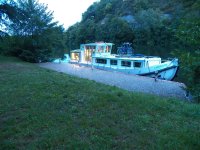I have been watching two series on Amazon Prime, "Cruising the Cut" and "Travels by Narrowboat". They are about living aboard and traveling the canals of England.
Apparently during the industrial revolution in England, during the 1700s, the main means of commercial transportation were narrowboats on the 2,500 miles of man made canals. Today these canals are maintained by the state for recreational use only. They are much like the Erie Canal and the network of canals in the north of our country.
These boats, today, are about 10 ft wide by +50 ft long, with a tucked under prop and a tiny diesel engine. Top speed is 4 kts. I would guess they draw a foot or two and are mostly made of steel. Most are very modern and houseboat like. Some of these canals are wide but many are 25 ft or so, and watching helmsmen maneuvering these long narrow boats around curves, junctions, through tunnels, passing, etc. is amazing to see.
Both of the series cover several seasons and are quite fascinating.
Apparently during the industrial revolution in England, during the 1700s, the main means of commercial transportation were narrowboats on the 2,500 miles of man made canals. Today these canals are maintained by the state for recreational use only. They are much like the Erie Canal and the network of canals in the north of our country.
These boats, today, are about 10 ft wide by +50 ft long, with a tucked under prop and a tiny diesel engine. Top speed is 4 kts. I would guess they draw a foot or two and are mostly made of steel. Most are very modern and houseboat like. Some of these canals are wide but many are 25 ft or so, and watching helmsmen maneuvering these long narrow boats around curves, junctions, through tunnels, passing, etc. is amazing to see.
Both of the series cover several seasons and are quite fascinating.

